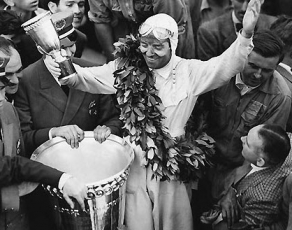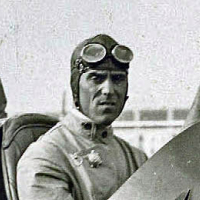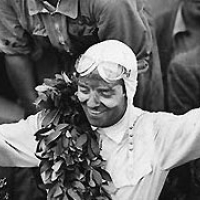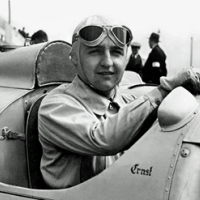
1937 Vanderbilt Cup Race
Germany captures the Cup
Location: Roosevelt Raceway, Westbury, New York
Date: July 5, 1937
From THE GOLDEN ERA OF GRAND PRIX RACING
1937 Vanderbilt Cup Race- Roodevelt Raceway, Westbury, New York
ROOSEVELT RACEWAY - New York (USA), 5 JULY 1937 (Monday) (delayed two days due to rain)
90 laps x 5.64 km (3 1/3 miles) = 482.8 km (300 miles)
Both German teams and Scuderia Ferrari decided to go to New York for the 1937 Vanderbilt cup, after the organizers had promised to move the race from July 4th to July 3rd so that there were ample time for the teams to catch the ship home even in case of a race delay due to rain. As the race clashed with the Belgian GP it meant that the teams were split up, with two drivers from each team entering each race. The German teams entered SS. Bremen (Note 2) in Bremerhaven 22 June, while the Ferrari team went to Le Havre and entered SS Normandie (Note 3). On Normandie Nuvolari who recently had lost his father learned the terrible news that his oldest son Giorgio had died (Note 4).
The track had been changed since last year and made more faster. The European drivers did not particularly like the track, however, the hidden curves making it hard to find the brake points. For some curious reason the American organizers had asked the Germans to paint swastikas on their cars. (Note 5)
Qualifying speed was was taken as the avarage for 10 laps with 3 attempts permitted. Caracciola was fastest in practice from Rosemeyer and Californian driver Rex Mays, who raced in the Alfa Romeo 8 cylinder car that had been used as a spare car for the Ferrari team during the 1936 race. The car was heavily modified and with a new larger supercharger Mays proved to be faster than the works 12 cylinder cars to the disgust of the Ferrari team.
Before the race the Mercedes-Benz team decided to change to the new suction carburettor supercharger system on all their cars to better the supercharger response at medium revs. Mercedes would retain the new system; gone forever was now the typical Mercedes-Benz scream of the blower supercharger that had filled the GP races since Eifelrennen 1934.
Race:
At Saturday 1.30 PM when the cars were already lined up for the start it began to rain. The race was immediately postponed until Monday.
At 2 PM Monday 5th 80,000 spectators finally saw Ralph de Palma wave the flag. Rosemeyer pulled his Auto Union hard to the left and took the first corner in front of Caracciola and Mays. Then followed Nuvolari, Seaman and Farina. On lap two Seaman moved into fourth position and on the next lap Caracciola took over the lead and opened up a 6 seconds gap. American Billy Winn was doing a great job having passed Farina and Nuvolari and was fighting with Seaman for fourth place before having to fall back with mechanical problems. On lap 11 it was Rosemeyer's turn to take the lead, he and Caracciola having a tough fight and pulling away from the others. Mays was still third now followed by Nuvolari, who had decided to start after all. Nuvolari was driving flat out as usual, having already passed Seaman. Nuvolari's efforts ended on lap 16 when the engine could not stand the pace anymore and threw a rod.
Caracciola was the next to retire with supercharger failure on lap 22. Caracciola was however not particularly disappointed as the America trip doubled as his and "Baby's" honeymoon trip. Seaman had started to advance and the order was now Rosemeyer, Seaman, Mays, von Delius and Farina.
On lap 38 Rosemeyer made a 35 seconds pitstop for fuel and tyres, Seaman now being the new leader by 30 seconds. Mays was also in for a 78 seconds stop and at lap 40 Farina came in and gave over his car to Nuvolari.
Rosemeyer pulled in Seaman's lead and caught the Mercedes just as Seaman pulled into the pits for his stop on lap 46. The order after the pitstops were: Rosemeyer, Seaman, Mays, von Delius, Nuvolari, Winn and Horn.
Nuvolari was in great form, passing von Delius and then challenging and passing Mays. But on lap 50 the Flying Mantuan was back in the pits having destroyed his second engine of the day and gave back the Alfa to Farina, who limped on to finish fifth after having to do an extra pitstop on lap 70.
Near the end Seaman was rapidly closing in on Rosemeyer but then the Mercedes run out of fuel and Seaman had to make an unscheduled stop one lap from the finish, leaving Rosemeyer to win by 50 seconds.
After having been promoted to SS-Obersturmführer for his victory at Eifelrennen 1936, Rosemeyer was now promoted to SS-Hauptsturmführer (Captain).
Prizes: First: $20,000; second, $10,000; third, $5,000; fourth, $3,500; fifth, $3,000; sixth, $2,200; seventh, $1,800; eighth, $1,600; ninth, $1,500; tenth, $1,400. Consolation money outside first ten: $10,000




Really think the couple up on Jericho Tpke are the same couple that officially toured the LIMP 1958 - 1967. Could also…